Preparing Society for Automated Vehicles: Perceptions of the Importance and Urgency of Emerging Issues of Governance, Regulations, and Wider Impacts
Abstract
:1. Introduction
2. Literature Review
2.1. AV Impact, Governance, and Regulation
2.2. Preparing for the Future
2.3. The Present Study
3. Research Methodology
3.1. Research Questions
- What are the perceptions of AI experts on the levels of importance and urgency toward the ten issues: governance, regulation considerations, data privacy and cybersecurity, traffic/environmental/public health benefits, economic and industry, public acceptance, social equity, technology innovation, transportation planning, and infrastructure?
- What are the perceptions of CS/EE majors on the levels of importance and urgency toward the ten issues: governance, regulation considerations, data privacy and cybersecurity, traffic/environmental/public health benefits, economic and industry, public acceptance, social equity, technology innovation, transportation planning, and infrastructure?
- Among the ten issues and background variables, what are the significant predictors for overall perceptions of the levels of importance and urgency upon AV development in Taiwan, according to CS/EE majors?
3.2. Participants
3.3. Measurements
3.3.1. Importance and Urgency on Ten AV Issues
- (1)
- Governance, 11 items, “How can we set clear road safety threshold and road safety specifications for AVs?”, and Alpha reliability for student sample: Importance (0.842) and Urgency (0.898).
- (2)
- Regulation consideration, 12 items, “In case of accidents involving autonomous vehicles, what is the legal responsibility of the owner of the autonomous vehicle?”, and Alpha reliability for student sample: Importance (0.89) and Urgency (0.926).
- (3)
- Data privacy and cybersecurity, 5 items, “How do we prevent the impact of information security (virus, hacker attack) of autonomous vehicles system networking on driving safety?”, and Alpha reliability for student sample: Importance (0.893) and Urgency (0.93).
- (4)
- Traffic, environmental, and public health benefits, 6 items, “What is the ideal operation of autonomous vehicles to reduce traffic accidents?”, and Alpha reliability for student sample: Importance (0.841) and Urgency (0.874).
- (5)
- Economy and industry, 7 items, “What may be the new economic benefits brought by the development of autonomous vehicles in the development of software and related industries?”, and Alpha reliability for student sample: Importance (0.859) and Urgency (0.902).
- (6)
- Public acceptance, 4 items, “Who should own and control the data of autonomous vehicles and the purpose of using the data?”, and Alpha reliability for student sample: Importance (0.826) and Urgency (0.832).
- (7)
- Social equity, 5 items, “What may be the possible relationship between autonomous vehicles and resource equality (e.g., will it benefit specific groups or improve the accessibility of transportation shared by the general public)?” Alpha reliability for student sample: Importance (0.843) and Urgency (0.861).
- (8)
- Technology and innovation, 5 items, “What is the new value of big data obtained and generated by planning autonomous vehicles in business and transportation?”, and Alpha reliability: Importance (0.859) and Urgency (0.887).
- (9)
- Transportation planning, 6 items, “How may autonomous vehicles resource control software be applied in traffic sign, traffic rules, and construction regulations?”, and Alpha reliability: Importance (0.874) and Urgency (0.881).
- (10)
- Infrastructure, 5 items, “What will be the possible damage and cost of the communication infrastructure needed for autonomous vehicle operation in the process of promotion?”, and Alpha reliability: Importance (0.903) and Urgency (0.91).
3.3.2. Overall Importance and Urgency of AV Development in Taiwan
4. Results
4.1. Importance and Urgency of the Ten Issues
4.1.1. Governance
4.1.2. Regulation Considerations
4.1.3. Data Privacy and Cybersecurity
4.1.4. Traffic, Environmental and Public Health Benefits
4.1.5. Economy and Industry
4.1.6. Public Acceptance
4.1.7. Social Equity
4.1.8. Technology and Innovation
4.1.9. Transportation Planning
4.1.10. Infrastructure
4.2. Overall Importance and Urgency of the Ten Issues
4.3. Predictions on the Importance and Urgency of AV in Taiwan by CS/EE Majors
5. Discussions
5.1. RQ1. What are the AI Experts’ Perceptions of the Levels of Importance and Urgency of the Ten Issues?
5.2. RQ2. What are the CS/EE Majors’ Perceptions of the Levels of Importance and Urgency of the Ten Issues?
5.3. RQ3. Among the Ten Issues and Background Variables, What are the Significant Predictors of Importance and Urgency of AV Development in Taiwan According to CS/EE Majors?
6. Conclusions
Author Contributions
Funding
Acknowledgments
Conflicts of Interest
References
- Milakis, D.; van Arem, B.; van Wee, B. Policy and society related implications of automated driving: A review of literature and directions for future research. J. Intell. Transp. Syst. 2017, 21, 324–348. [Google Scholar] [CrossRef]
- Milakis, D. Long-term implications of automated vehicles: An introduction. Transp. Rev. 2019, 39, 1–8. [Google Scholar] [CrossRef]
- Milakis, D.; Snelder, M.; van Arem, B.; van Wee, B.; de Almeida Correia, G.H. Development and transport implications of automated vehicles in the Netherlands: Scenarios for 2030 and 2050. Eur. J. Transp. Infrast. 2017, 17, 63–85. [Google Scholar]
- Lee, J.; Kockelman, K.M. Energy Implications of Self-Driving Vehicles, 98th ed.; Annual Meeting of the Transportation Research Board: Washington, DC, USA, 2019. [Google Scholar]
- Cohen, T.; Cavoli, C. Automated vehicles: Exploring possible consequences of government (non)intervention for congestion and accessibility. Transp. Rev. 2019, 39, 129–151. [Google Scholar] [CrossRef] [Green Version]
- Cohen, T.; Stilgoe, J.; Cavoli, C. Reframing the governance of automotive automation: Insights from UK stakeholder workshops. J. Responsib. Innov. 2018, 5, 1–23. [Google Scholar] [CrossRef]
- Fagnant, D.J.; Kockelman, K. Preparing a nation for autonomous vehicles: Opportunities, barriers and policy recommendations. Transp. Res. Part A Policy Pract. 2015, 77, 167–181. [Google Scholar] [CrossRef]
- Allen & Overy LLP. Autonomous and Connected Vehicles: Navigating the Legal Issues; Allen & Overy LLP: London, UK, 2017; pp. 2–17. [Google Scholar]
- Taeihagh, A.; Lim, H.S.M. Governing autonomous vehicles: Emerging responses for safety, liability, privacy, cybersecurity, and industry risks. Transp. Rev. 2018, 39, 103–128. [Google Scholar] [CrossRef] [Green Version]
- Mladenović, M.N.; Stead, D.; Milakis, D.; Pangbourne, K.; Givoni, M. Governance cultures and sociotechnical imaginaries of self-driving vehicle technology: Comparative analysis of Finland, UK and Germany. In Policy Implications of Autonomous Vehicles; Elsevier: Amsterdam, The Netherlands, 2020; pp. 235–262. [Google Scholar]
- Hopkins, D.; Schwanen, T. Automated Mobility Transitions: Governing Processes in the UK. Sustainability 2018, 10, 956. [Google Scholar]
- Threlfall, R. 2018 Autonomous Vehicles Readiness Index. Available online: https://home.kpmg.com/xx/en/home/insights/2018/01/2018-autonomous-vehicles-readiness-index.html (accessed on 17 August 2020).
- Threlfall, R. 2019 Autonomous Vehicles Readiness Index. Available online: https://home.kpmg/xx/en/home/insights/2019/02/2019-autonomous-vehicles-readiness-index.html (accessed on 17 August 2020).
- Threlfall, R. 2020 Autonomous Vehicles Readiness Index (AVRI). Available online: https://home.kpmg/xx/en/home/insights/2020/06/autonomous-vehicles-readiness-index.html (accessed on 17 August 2020).
- Li, S.; Sui, P.-C.; Xiao, J.; Chahine, R. Policy formulation for highly automated vehicles: Emerging importance, research frontiers and insights. Transp. Res. Part A Policy Pract. 2019, 124, 573–586. [Google Scholar] [CrossRef]
- Ross, C.; Guhathakurta, S. Autonomous Vehicles and Energy Impacts: A Scenario Analysis. Energy Procedia 2017, 143, 47–52. [Google Scholar] [CrossRef]
- Liu, F.; Zhao, F.; Liu, Z.; Hao, H. Can autonomous vehicle reduce greenhouse gas emissions? A country-level evaluation. Energy Policy 2019, 132, 462–473. [Google Scholar] [CrossRef]
- Papa, E.; Ferreira, A. Sustainable accessibility and the implementation of automated vehicles: Identifying critical decisions. Urban Sci. 2018, 2, 5. [Google Scholar] [CrossRef] [Green Version]
- Marletto, G. Who will drive the transition to self-driving? A socio-technical analysis of the future impact of automated vehicles. Technol. Forecast. Soc. Chang. 2019, 139, 221–234. [Google Scholar] [CrossRef]
- Staricco, L.; Rappazzo, V.; Scudellari, J.; Vitale Brovarone, E. Toward Policies to Manage the Impacts of Autonomous Vehicles on the City: A Visioning Exercise. Sustainability 2019, 11, 5222. [Google Scholar] [CrossRef] [Green Version]
- Cohen, T.; Jones, P.; Cavoli, C. Social and Behavioural Questions Associated with Automated Vehicles. 2019. Available online: https://pdfs.semanticscholar.org/80f8/2a120ee4d367f0c52892dccccf5629f6a228.pdf (accessed on 17 August 2020).
- Chen, S.Y.; Lee, C.C. Perceptions on the impact of high-level-machine- intelligence from university students in Taiwan: The case for human professions, autonomous vehicles, and smart homes. Sustainability 2019, 11, 6133. [Google Scholar] [CrossRef] [Green Version]
- Chang, C.L. Automated Vehicles Are Coming, Are Technological Development and Corresponding Policy Ready for It in Taiwan? The Small and Medium Enterprise Administration’s Innovative Financing Intelligent Support Project. 2019. Available online: https://findit.org.tw/researchPageV2.aspx?pageId=934 (accessed on 17 August 2020). (In Chinese).
- Zou, L.; Chang, S.K. The Challenge and Impact of Autonomous Vehicle Development in Taiwan: Socioeconomic Impact; China Technical Consultants Inc. (CTCI Foundation): Taipei, Taiwan, 2018. [Google Scholar]
- The IEEE Global Initiative on Ethics of Autonomous and Intelligent Systems. In Ethically Aligned Design: A Vision for Prioritizing Human Well-Being with Autonomous and Intelligent Systems, 1st ed.; IEEE: Piscataway, NJ, USA, 2019; Available online: https://ethicsinaction.ieee.org (accessed on 12 September 2020).
- Independent High-Level Expert Group on Artificial Intelligence. “Ethics Guidelines for Trustworthy AI” European Commission. April 2019. Available online: https://ec.europa.eu/futurium/en/ai-alliance-consultation (accessed on 12 September 2020).
- STPI. Autonomous Vehicles Data Management Platform and Regulation on Road Safety; Science and Technology Policy Research and Information Center: Taipei, Taiwan, 2020; Available online: https://outlook.stpi.narl.org.tw/index/focus-news?id=4b11410072c0d7000172e5217de223f5 (accessed on 17 August 2020).
- Shih, A. Autonomous Vehicles Industry Planning and Development Strategies in Taiwan; Industrial Technology Research Institute: Hsin-Chu, Taiwan, 2019; Available online: https://www.automan.tw/news/newsContent.aspx?id=2725 (accessed on 17 August 2020).
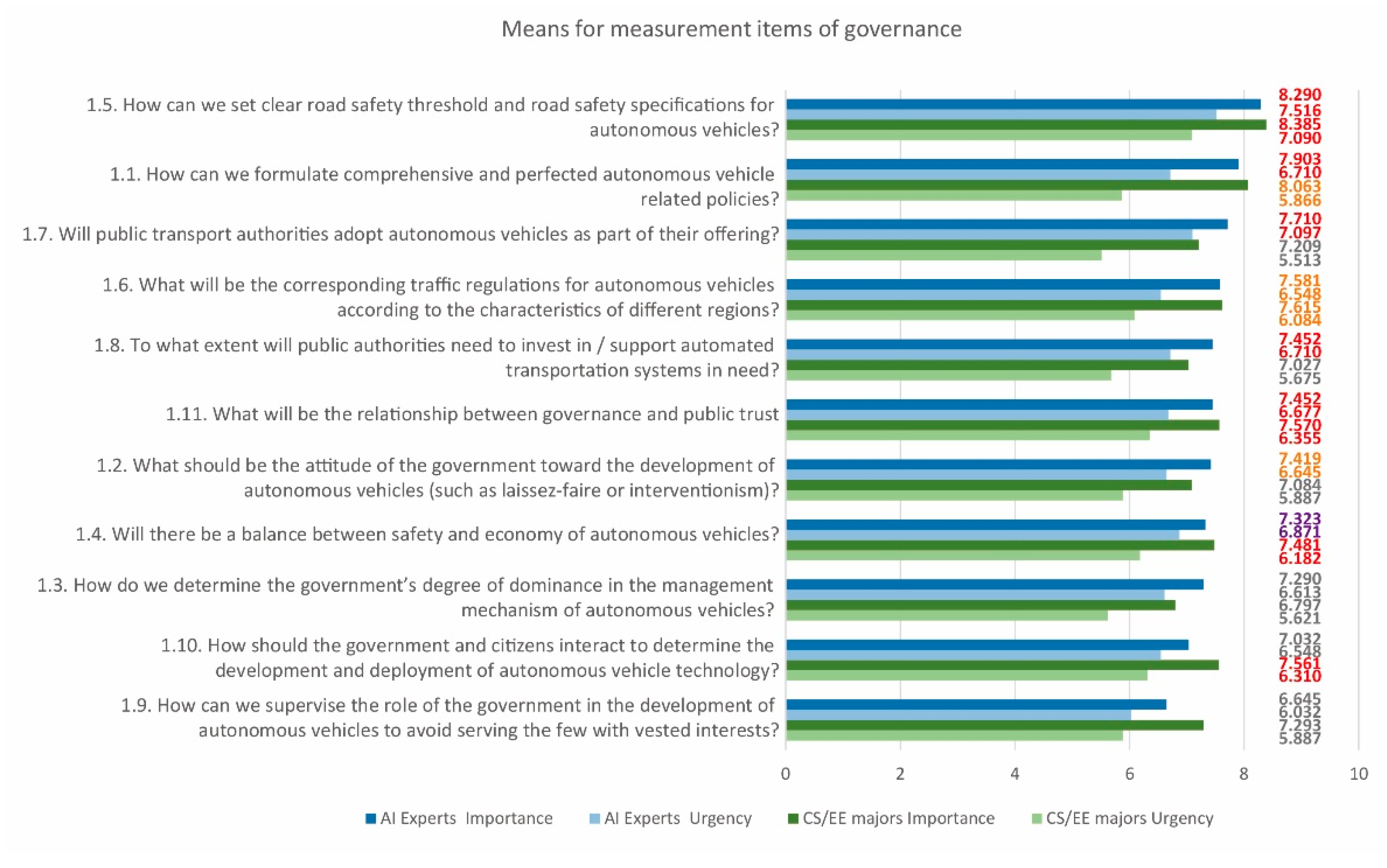
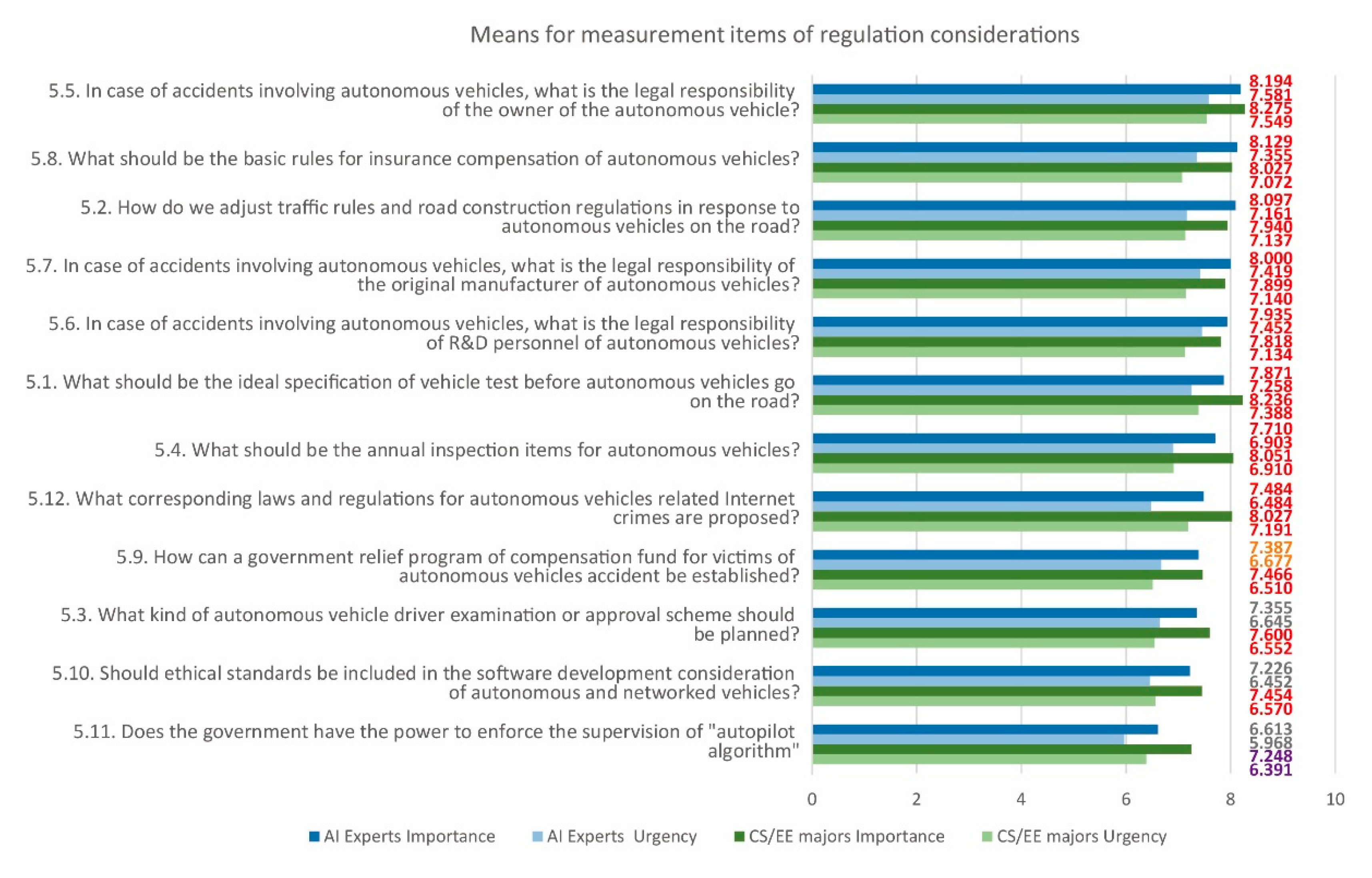
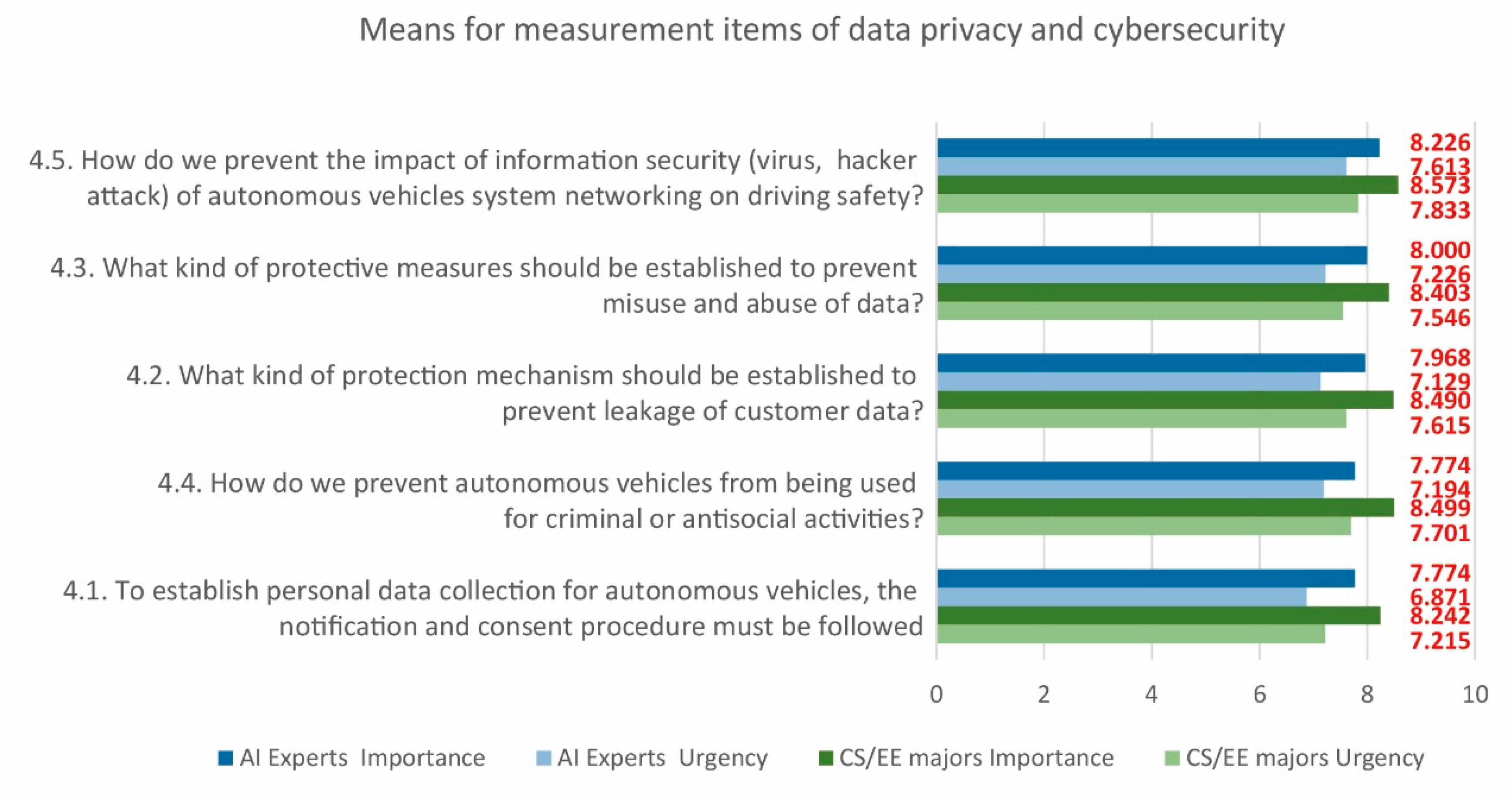
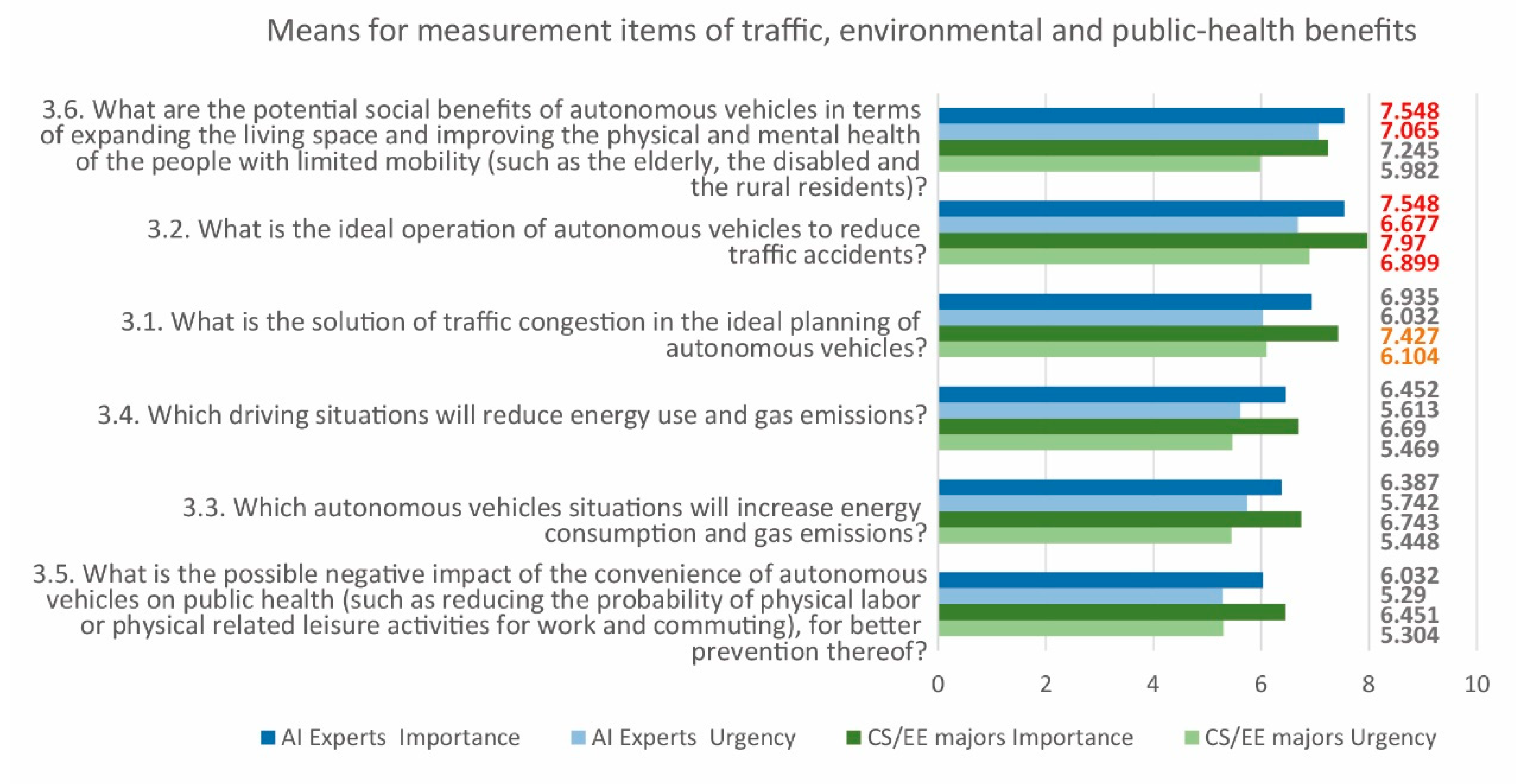
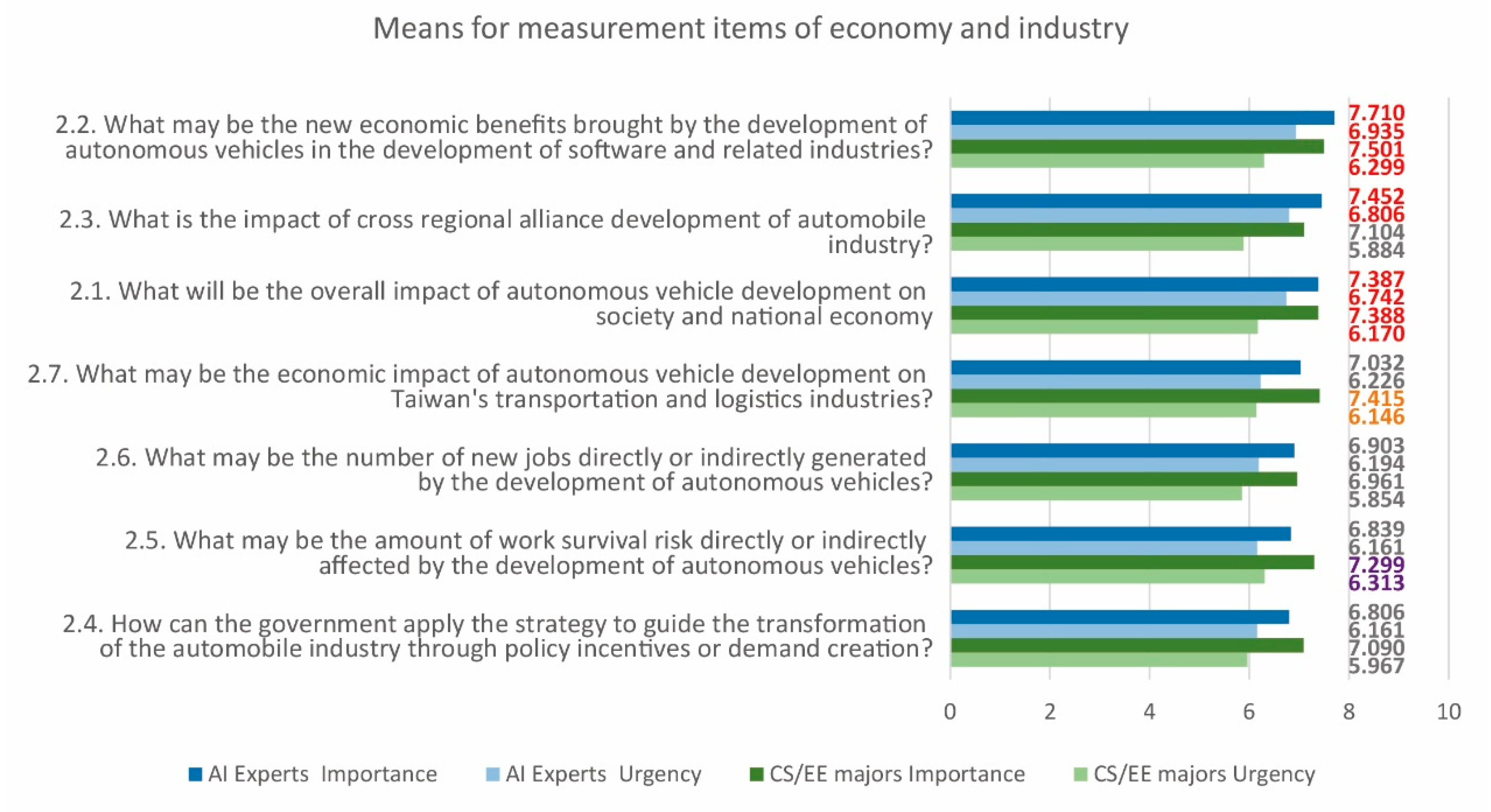
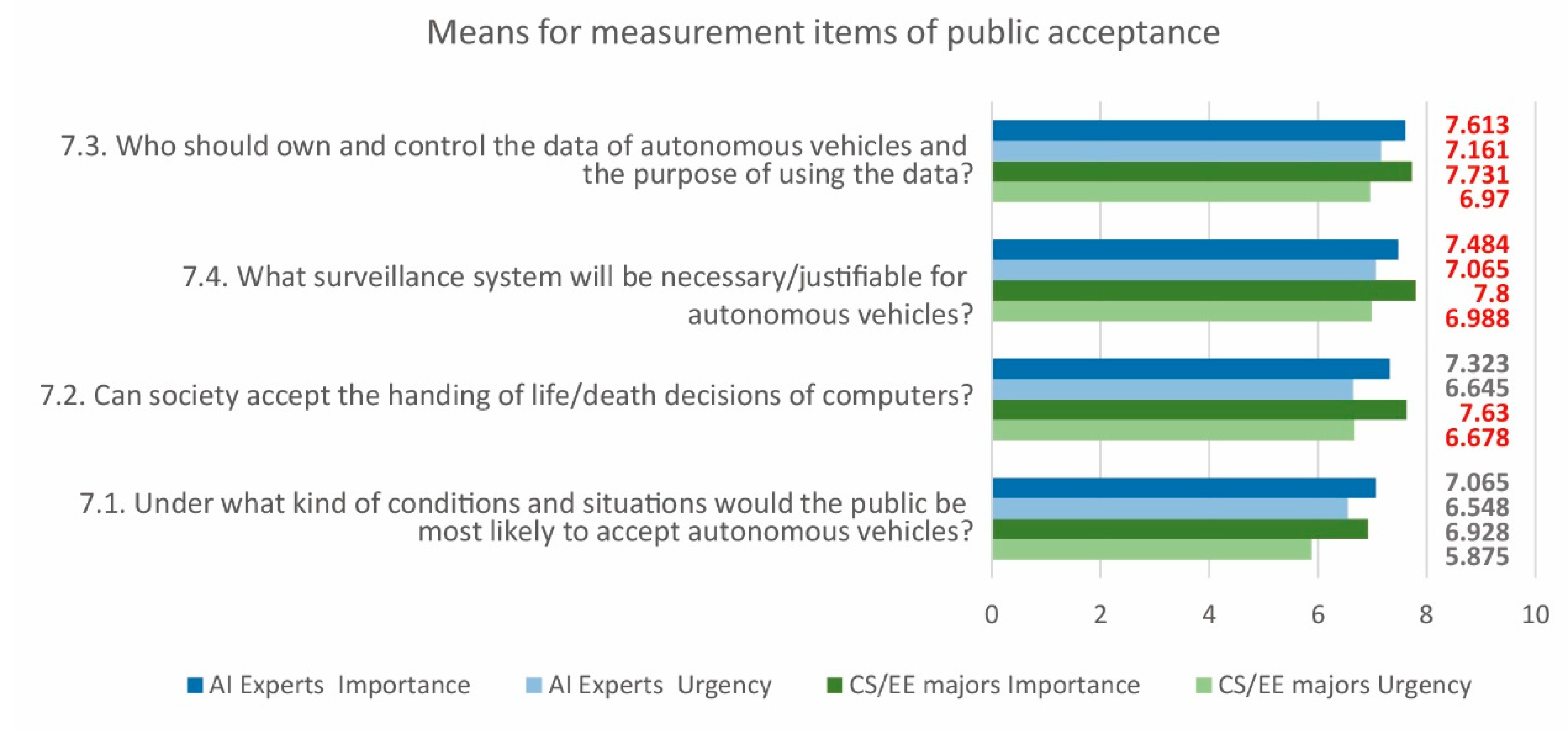
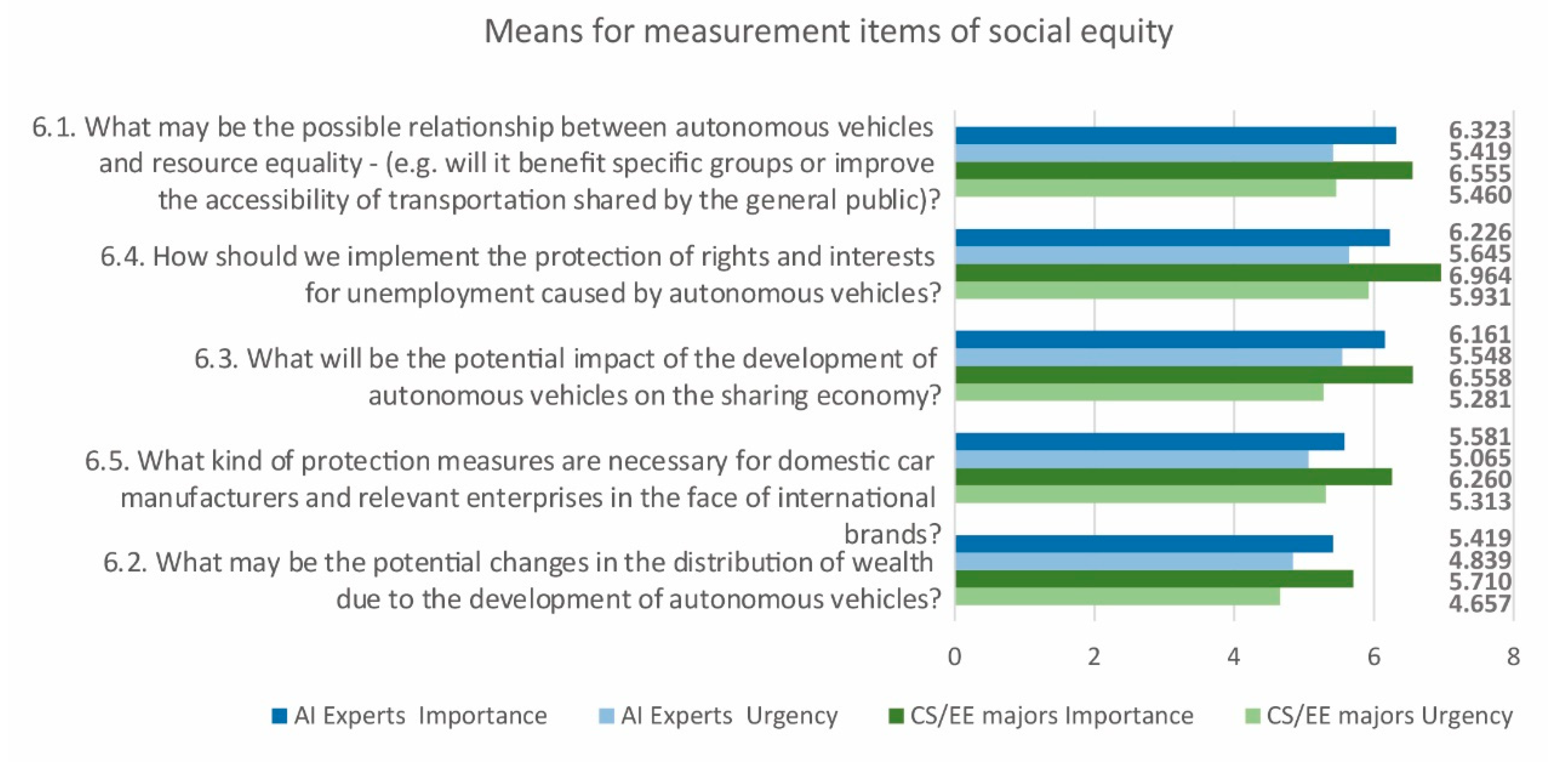
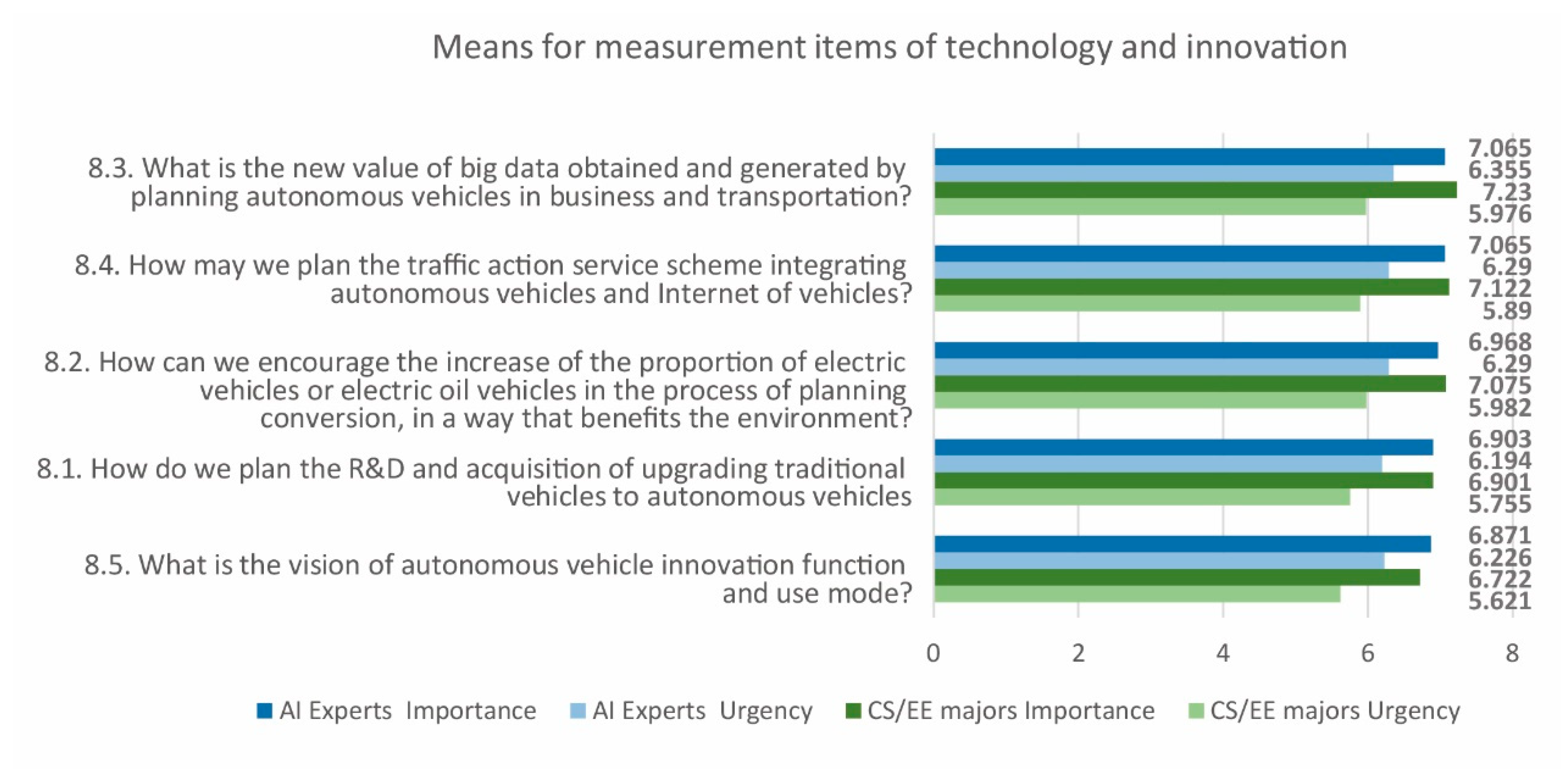
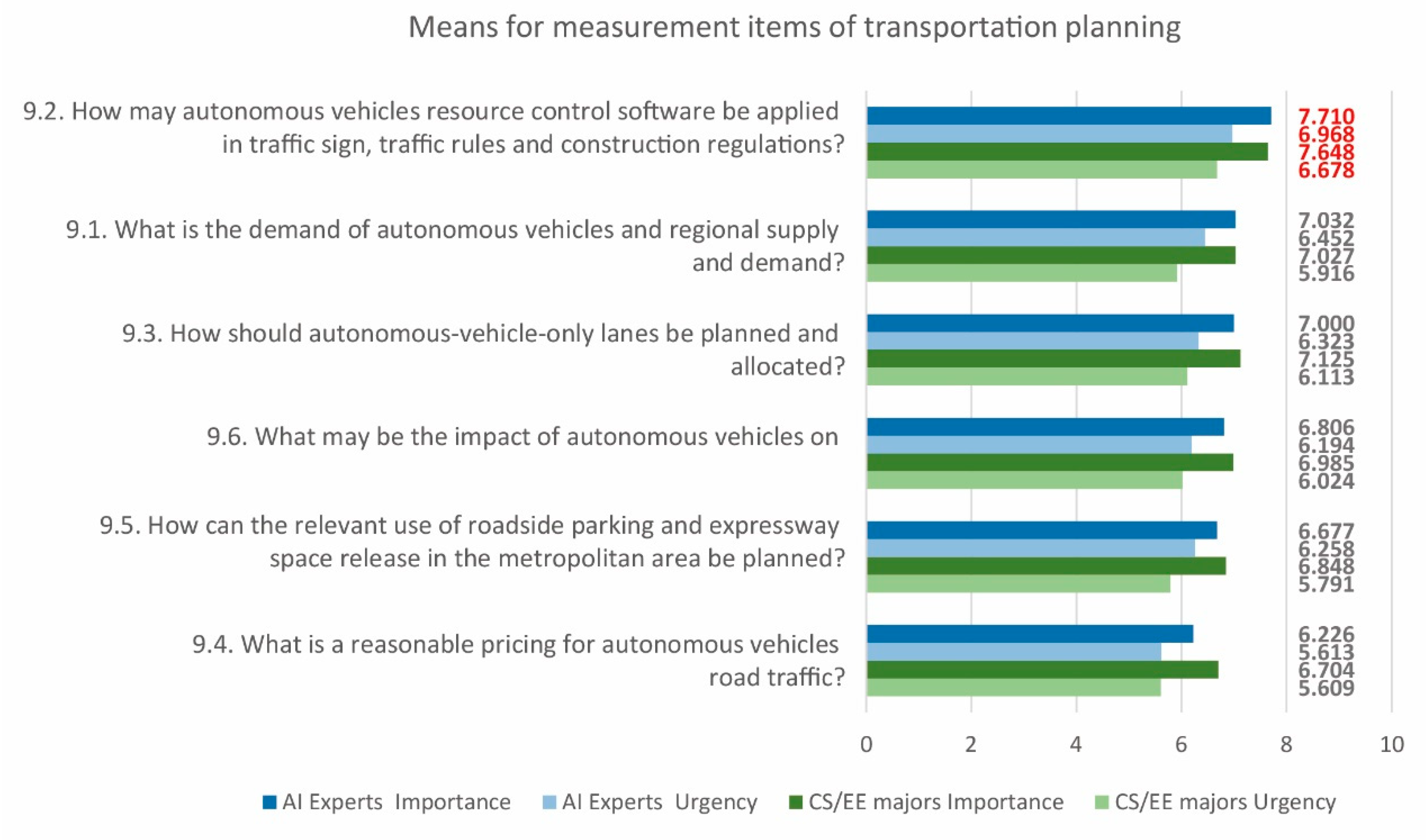
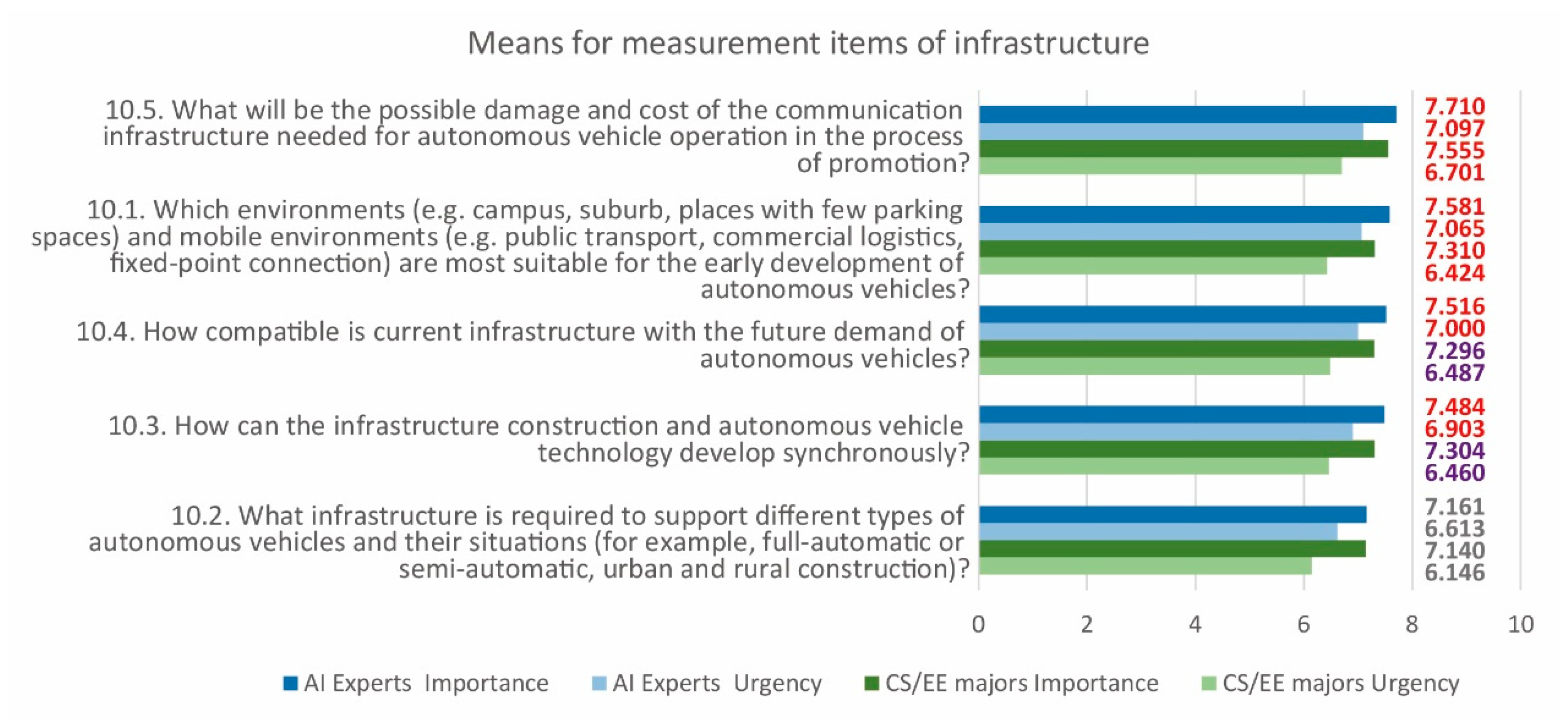
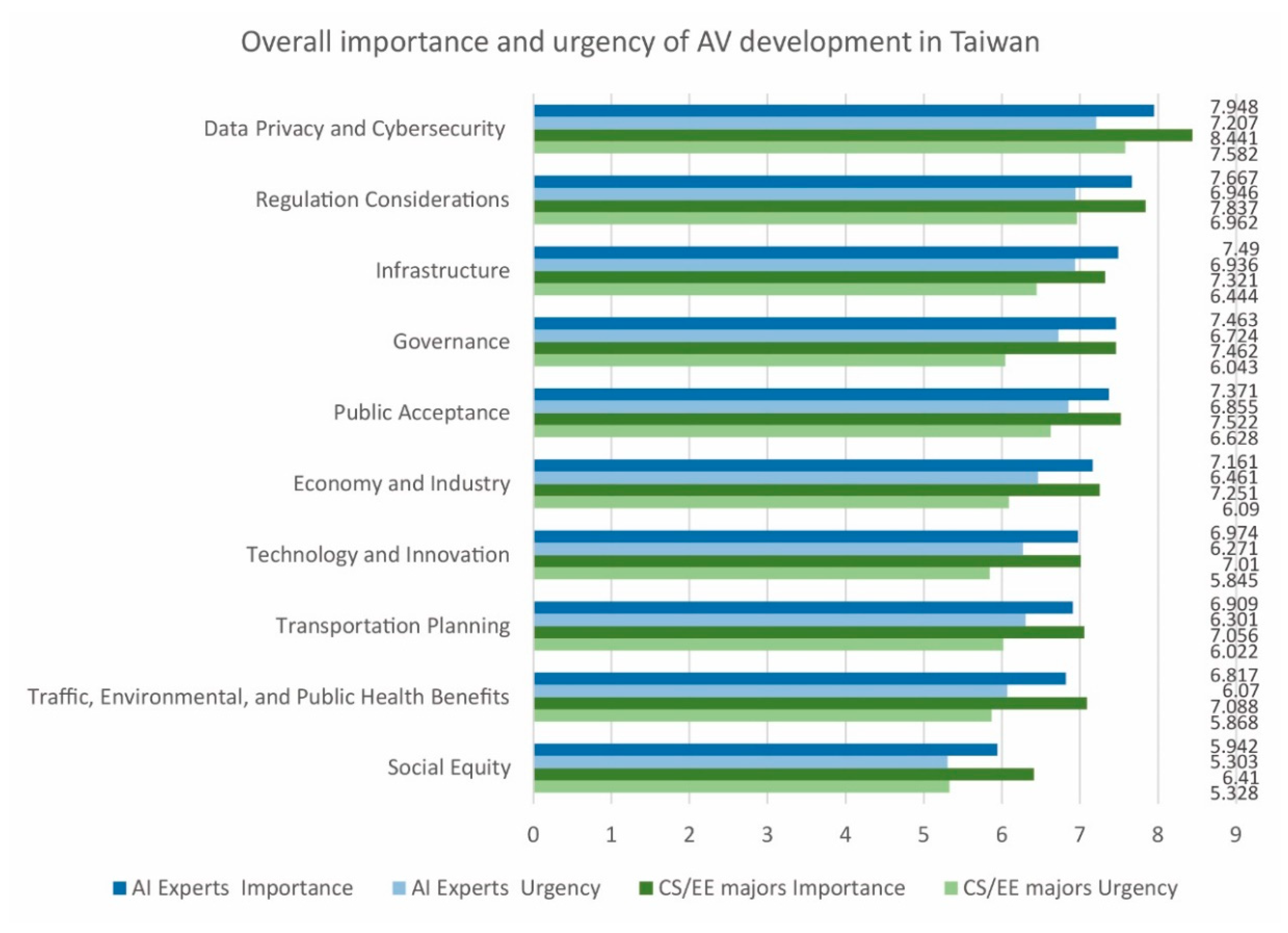
| Variables | AI Experts Percentage (%) | CS/EE Majors Percentage (%) | |
|---|---|---|---|
| Gender | Male | 93.5 | 67.5 |
| Female | 6.5 | 32.5 | |
| Level | Undergraduate | 0 | 49.3 |
| Master | 0 | 44.5 | |
| Ph. D | 100 | 6.3 | |
| What Do You Think Is the Importance of the Development of Autonomous Vehicles in Taiwan? | What Do You Think Is the Urgency of the Development of Autonomous Vehicles in Taiwan? | |||
|---|---|---|---|---|
| Variable | β | t-Value | β | t-Value |
| Gender | 0.126 | 2.562 * | 0.047 | 1.079 |
| Level | −0.019 | −0.393 | −0.014 | −0.320 |
| Data Privacy and Cybersecurity | 0.108 | 1.763 | −0.135 | −2.262 * |
| Regulation Considerations | 0.007 | 0.099 | −0.136 | −2.057 * |
| Infrastructure | 0.155 | 2.301 * | 0.131 | 2.146 * |
| Governance | 0.115 | 1.647 | 0.309 | 4.219 *** |
| Public Acceptance | −0.098 | −1.429 | 0.007 | 0.113 |
| Economy and Industry | 0.067 | 0.947 | 0.185 | 2.411 * |
| Technology and Innovation | 0.271 | 3.897 *** | 0.248 | 3.775 *** |
| Transportation Planning | 0.046 | 0.648 | 0.043 | 0.658 |
| Traffic, Environmental, and Public Health Benefits | −0.084 | −1.183 | −0.003 | −0.046 |
| Social Equity | 0.054 | 0.801 | 0.051 | 0.819 |
| DF | (12, 322) | (12, 322) | ||
| Adj. R2 | 0.261 | 0.422 | ||
| F-value | 10.832 *** | 21.333 *** | ||
© 2020 by the authors. Licensee MDPI, Basel, Switzerland. This article is an open access article distributed under the terms and conditions of the Creative Commons Attribution (CC BY) license (http://creativecommons.org/licenses/by/4.0/).
Share and Cite
Chen, S.-Y.; Kuo, H.-Y.; Lee, C. Preparing Society for Automated Vehicles: Perceptions of the Importance and Urgency of Emerging Issues of Governance, Regulations, and Wider Impacts. Sustainability 2020, 12, 7844. https://doi.org/10.3390/su12197844
Chen S-Y, Kuo H-Y, Lee C. Preparing Society for Automated Vehicles: Perceptions of the Importance and Urgency of Emerging Issues of Governance, Regulations, and Wider Impacts. Sustainability. 2020; 12(19):7844. https://doi.org/10.3390/su12197844
Chicago/Turabian StyleChen, Su-Yen, Hsin-Yu Kuo, and Chiachun Lee. 2020. "Preparing Society for Automated Vehicles: Perceptions of the Importance and Urgency of Emerging Issues of Governance, Regulations, and Wider Impacts" Sustainability 12, no. 19: 7844. https://doi.org/10.3390/su12197844
APA StyleChen, S.-Y., Kuo, H.-Y., & Lee, C. (2020). Preparing Society for Automated Vehicles: Perceptions of the Importance and Urgency of Emerging Issues of Governance, Regulations, and Wider Impacts. Sustainability, 12(19), 7844. https://doi.org/10.3390/su12197844





